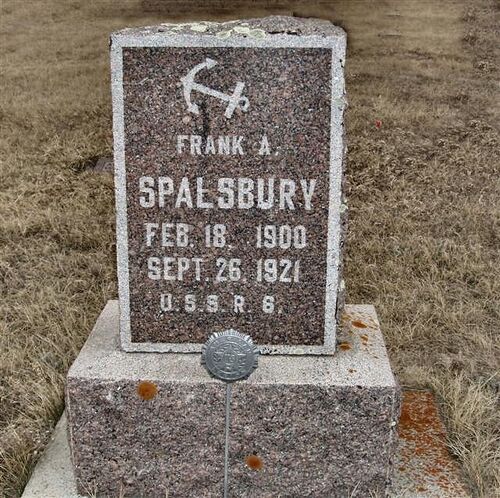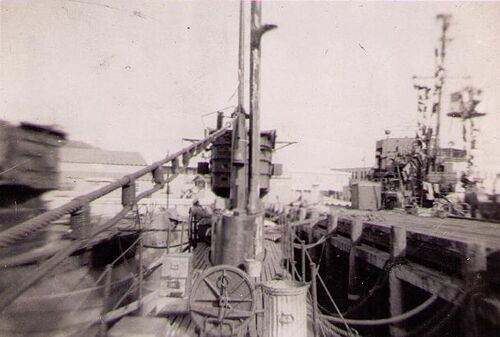R-6 Recovery
R-6 Sinking and Recovery

The keel for the R-6 (Submarine No. 83) was laid down December 17, 1917, eight months after America had entered WW I, by the Fore River Shipbuilding Co., in Quincy, Mass. She was launched March 1, 1919, five months after WW I had come to a close. Naval ships have sponsors and hers was Miss Katherine Langdon Hill. She was finally commissioned at Boston May 1, 1919, Lt. Comdr. Charles Milford Elder was placed in command. On May 29, 1919 Lieutenant Lyman K. Swanson relieved captain Elder of command of the R-6.
After fitting out at Boston, the R-6 reported to Submarine Division 9 of the Atlantic Fleet stationed at New London, Conn. on September 16, 1919.
On November 30, 1919 a large storm assailed Long Island Sound and the Connecticut coast. The submarine tender Camden was anchored at the mouth of the Thames River. The storm dislodged the ships anchors and they dragged. Do to the storm the R-6 had cast off from the Camden and set her own anchor. Both vessels dragged and grounded on Black Ledge, a pile of rocks at the mouth of the river. Numerous attempts to drag her off were made before she was freed. The submarine was examined and it was determined that she had sustained little damage.
The R-6 got underway December 4 of that year for Norfolk and winter exercises with her division in the Gulf of Mexico. This cruise was made famous in the song 'The cruisin’, shootin’ boys of SubDiv Nine' where it is suggested in the song that the R-6 had to set a sail due to a breakdown. A lot of the boats had many mechanical failures during this trip. Part of the purpose of these exercises was to prove the value of submarines against a surface fleet. These fleet exercises lasted from January 21 to April 14, 1920. She returned to New London and arrived at the Submarine Base on May 18th for 4 months of summer maneuvers before sailing on September 13 for Norfolk and an overhaul. She had been in service for a year and many things had been cropping up that needed repair that couldn't be fixed by the crew.
While with Division 9, the R-6 was designated SS-83 in July 1920, all submarines at this time were assigned a hull number designator like this. She was ordered to the Pacific Fleet on April 11, 1921; (the 21st anniversary of the creation of the US Submarine Service) and transited the Panama Canal on May the 28th. She arrived at her new base at San Pedro, Calif on June 30th.
On September 26 , 1921 while stationed at San Pedro Submarine Base she was moored in a nest to the side of the tender Camden which was anchored in the harbor. The R-6 was making preparations for battle practice the next day. The Commanding Officer, Lt. Irving R. Chambers, was aboard as well as two other junior officers, Lieut. S. D. Juts and J. M. Steel. The torpedo gang was making 'fish' ready and looking over systems in the torpedo room. They were working late and and were hard at it far into the night. The operations the next day were to involve the firing of exercise torpedoes that had a dummy warhead that was filled with water. When the torpedo reached the end of its run a mechanism in the torpedo was to blow air into the head and blowing out all the water make the torpedo float nose up making it easy to retrieve.
During this time a malfunction in one of her torpedo tubes interlock systems caused the inner and outer doors to be able to be opened at the same time. The crew was unaware of this. It is unclear from the reports from that time why the interlock failed but apparently the shutter door and outer door of one of the tubes was open or partly open and water pressure caused the inner door to fail and water began flooding the torpedo room.
The startled crew ran from the room into the forward battery compartment. Others escaped through the torpedo room deck hatch. One man seeing what was happening raced to the deck an chopped the mooring lines that held the R-6 to the nest of submarines moored to the tender Camden. The weight of the flooded submarine would have pulled the other submarines under as well.
The reports say that Electricians Mate second class Frank A Spalsbury and Seaman John E Dreffien were among those aboard. Witnesses say they heard a small explosion inside the submarine and at that time Electrician Spalsbury was seen to be launched into the air from the conning tower hatch, from which he was trying to escape,and land in the water. At first it was thought that Seaman Dreffien and one other were trapped inside the submarine and had managed to secure themselves in a compartment.
The submarine continued to flood and reports also say that Lieut Chambers was the last officer to leave the submarine and he began at once to help other men in the water to safety and didn't stop until all men were assisted. The R-6 settled in 35 feet of water on the harbor bottom.
At first light work began in hopes of saving those inside the submarine. A large crane that was working in the harbor was brought over and divers went down to attach ropes to the submarine. They also tapped on the hull to see if there was any response from inside. Over the night one of the missing men had been located so it was only Seaman John Dreffein unaccounted for and presumed inside the hull. The submarine proved to be too heavy for the crane to lift.

Courtesy of FindAGrave.com
Several days later, on the 29th, Electrician Spalsburys' body was found on the bottom of the harbor only about ten feet from his sunk submarine.
Frank Amzi Spalsbury was born and raised in a modest farming town in Northwest North Dakota named Powers Lake. Born on February 18, 1900, he was the son of Arthur Amzi 'Arthur W.' Spalsbury and Elizabeth Ann 'Bessie' Hall Spalsbury. He had a younger brother named Edward Arthur and another named Alan W. His father was a Stone mason. According to Powers Lake town historian, Larry Tinjum, the father was responsible for most of the towns cement work in the early years of the towns creation. At age 18 and WW I raging in Europe, Frank registered for the draft but joined the Navy. He had risen to the rank of Electricians Mate 2/Class at the time of his death. He was returned to Powers Lake is and buried at Bethel Cemetery just to the southwest of the town. He lies there under a beautiful red granite head stone.
Finally on October 13 the R-6 was refloated with the assistance of the R-10 who provided the pressure air to expel the water from the R-6 hull and the USS Cardinal AM-6.
Once the R-6 was back on the surface and crews could get aboard, the body of Seaman John E Dreffein was located. Little can be found about this man. He seems to have been born in Three Oaks, Michigan and born on August 27, 1898. He was buried in the Rock Island National Cemetery in Rock Island, Illinois, Plot: SE–453. There seem to be a number of Dreffein names in the Illinois area so it is quite possible there are family in that area.
Once the R-6 was repaired she was sent back to the fleet for duty. She was given a unique task in 1923. From February 26 to March 2, of that year, the R-6 was used by Twentieth Century-Fox in making the motion picture, 'The Eleventh Hour.' There are several movies made with this name over the years but no account can be found of this movie made in 1923.
Orders came to the Sub Division and the R-6 and they were transferred on July 16, 1923 to Hawaii and Pearl Harbor where she remained for the next 8 years engaged in training and operations with fleet units. This part is also mentioned in the song named above when SubDiv 9 was transferred to 'Hula Town'.
Finally the R-6 was recalled to the Atlantic and on December 12, 1930, answering those orders, she departed The Hawaiian Islands and transited the Panama Canal January 18, 1931. She arrived on February 9th at Philadelphia Navy Yard where she was decommissioned May 4, 1931.
The R-6 sat in ready reserve for 9 years until she was needed once more. She was recalled to active service and recommissioned at New London Submarine Base on November 15, 1940. The R-6 was assigned to Division 42 and departed December 10, 1940 for the submarine base at Coco Solo, C.Z., where she remained carrying out operations until June 16 ,1941. She was then transferred to Division 31 at St. Thomas, V.I., on June 22, 1941 and operated in those waters until she was ordered to return to New London October 8 for a refit.
The submarine next joined the anti-U-boat patrol operating roughly on a line between Nantucket and Bermuda. Through 1942 she rotated between New London and Bermuda, conducting submerged periscope patrols by day and surface patrols at night to protect coastal traffic. From 1943 to mid 1945 she was employed primarily in training destroyers and destroyer escorts in antisubmarine warfare. In 1945 she moved south to Florida and operated in the Port Everglades-Key West area.

Between April and August 1945 the R-6 was involved in testing the Unites States version of the Snorkel. The Snorkel had been invent and perfected by the Dutch and they had even offered the technology to the US Navy but was rejected. The Germans took the technology after invading Holland and incorporated it into their submarines late in WW II. This caught the eye of the US Navy and research was begun. The first US made Snorkel was tested using the USS R-6 in August 1945, operating out of Fort Lauderdale, Florida. There is only one known set of photos of this installation and configuration. Once trials were complete the Snorkel was removed.
R-6 decommissioned at Key West September 27 and was struck from the Navy list October 11, 1945. She was sold for scrap to Macey O. Scott, Miami, Fla., in March 1946.
Page created by:
Ric Hedman & David Johnston
1999 - 2023 - PigBoats.COM©
Mountlake Terrace, WA, Norfolk, VA
webmaster at pigboats dot com
